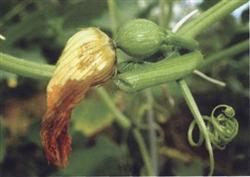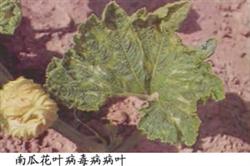Chemical control measures of pumpkin flower rot

Symptoms: also known as fruit rot. Open field and protected land occur frequently, and the protected land is particularly serious. the damage has been on the rise in recent years, and the output has been reduced by about 30%. It is called flower rot or fruit rot when harming pumpkins, melons and watermelons, and brown rot, commonly known as rotten eggs, when harming squash and zucchini. Flower rot harms the flowers and young fruits of pumpkins. The diseased fruits show wet rot like water stains, and the diseased flowers become brown and rotten. The pathogen invaded the young melon from the female pedicel and spread to the melon, and the outside of the diseased melon gradually turned brown. The surface of the diseased part was white and fluffy, and sometimes grayish brown or black needles could be seen, different from Botrytis cinerea. After rain or under high humidity conditions, the disease spreads rapidly, causing a batch of male flowers, female flowers and young melons to rot, half or all melons turn brown when dry, and the yield is seriously reduced. The disease occurs in the bushes and is easy to be ignored. in fact, it does great harm. Pumpkin blossoms a lot, and sometimes there are few melons, mainly caused by rotten flowers and rotten eggs. In production, attention should be paid to the difference between gray mold and prevention and control. Pathogens: Fusarium oxysporum, Penicillium northeastern, Phanerochaete chrysosporium, all belong to zygotic fungi. There are two kinds of sporangia: the large sporangium is 170 microns in diameter, and the small sporangium contains only one spore, which acts like a conidia. In order to harm melons, causing flowers and fruits to rot. Northeast mildew causes pumpkin flower rot. Cunninghamia lanceolata cyst stem branch pseudoaxis, showing a cymose or irregular shape, small sporangium spherical, with long spines, parasitic on pumpkin flowers. Transmission route and disease condition: the pathogen overwintered with mycelium in the soil with disease remains or produced zygotic spores, and produced spores to infect flowers and young fruits in the next spring. After onset, the disease produced a large number of spores, which were transmitted by wind, rain or insects, invading weak flowers and fruits from the wound or young epidermis. After the disease, the disease department produced a large number of spores to re-infect by wind and rain for many times, causing a batch of flowers and fruits to become sick until the end of the growing season. The disease is serious in years with many rainy days. Pollution-free prevention and control law: (1) Agricultural control: ① and non-melon crops for more than 3 years rotation ② with high border or high ridge cultivation, covered with plastic film; ③ almost the whole land, reasonable watering, strictly prohibit flood irrigation, timely drainage after rain, strictly prevent moisture retention; ④ picked diseased flowers and diseased fruits in time after fruit setting, and concentrated burning of diseased fruits until the last batch of melons could mature. (2) Chemical control: spray 78% wave manganese zinc (Cobo) wettable powder from flowering to young fruit stage or 86.2% cuprous oxide (copper master) wettable powder 1000 times, 47% Chunwang copper (Jiarinong) wettable powder 700x. (3) at the initial stage of the disease, 72% manganese-zinc cream urea (Kelu, Shuangmyujing, Shuangke, Sailu, Shuangke, Fute, Kesbao, Like cream) wettable powder 600 times liquid or 69% manganese zinc (Anke manganese zinc) wettable powder 700 times solution, 60% fluomanganese zinc (Mike) wettable powder 700-800 times. (4) in addition to paying attention to ventilation and reducing humidity in the protected area of the shed, it is recommended to use chlorothalonil smoke remover, 250g per 667 square meters, which is effective for one night after lighting.
- Prev

How to use drugs for pumpkin mosaic virus disease
Symptoms: the main symptoms are uneven distribution of chlorophyll, macula or deep and shallow mottled flowers and leaves, sometimes along the vein chlorophyll concentration increases, forming a dark green alternating zone, seriously causing the leaf surface to show uneven, wrinkled and deformed veins. In general, the symptoms of new leaves are more obvious than those of old leaves. In severe cases, the stem and parietal lobe are twisted. ...
- Next

Key points of yield increasing technique of pumpkin multi-plant joint grafting
Too much nitrogen fertilizer in the early growth stage can easily lead to excessive growth of plants, resulting in flower and fruit drop phenomenon, which can not ensure the uniformity and final product quality of melon. Therefore, it is necessary to control the amount of nitrogen fertilizer used and appropriately increase the proportion of phosphorus and potassium fertilizer. When needed, can be treated by pharmaceutical methods, can choose zucchini fruit king 1...
Related
- Where is it suitable to grow horseradish in China? it is expected to see the middle altitude horseradish in Alishan.
- How to prevent tomato virus disease reasonably? (Control methods included)
- Many people like to plant towel gourd on the balcony. What are the main points of this method and management?
- What crops can chili peppers be mixed with?
- Fertilization techniques and matters needing attention in Tomato
- What are the grafting techniques for peach seedlings in spring?
- Harm and control methods of root swelling disease of Chinese cabbage
- What are the pests of sweet potatoes? How to prevent and cure it?
- Symptoms, causes and Control methods of navel Rot in Tomato
- The cause of "Cucumber rotten bibcock" in Farmers' planting Cucumber and its Control Plan

